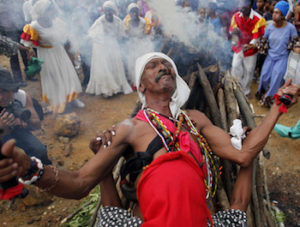
This date, from 1500, celebrates Santeria. Santeria is one of the many African-derived syncretistic religions that developed in the Americas.
The word syncretistic means to "draw together" or "combine." This involves combining elements from different or independent religious traditions to create a new belief system within a spiritual context. It exemplifies the intersectionality of African faith practiced from the 16th to the 21st century.
Santeria is based on West African religions that were brought to the New World through the Middle Passage, primarily to the Caribbean, to work the sugar plantations. These Africans carried their sacred traditions, including a ritual of possession trance for communicating with the ancestors and deities. They also brought animal sacrifice and the practice of sacred drumming and dance. The African slaves shipped to the Caribbean and Central and South America were nominally converted to Catholicism.
Santeria incorporates the worship of the Orisha (literally "head guardian") and beliefs of the Yoruba and Bantu people in Southern Nigeria, Senegal, and Guinea Coast by synchronizing these African cultures and religions with the surrounding elements of worship from Roman Catholicism. The process of typical baptism upon arrival suppressed the Africans' indigenous religious practices.
In Santeria, blacks away from the continent developed a way of keeping their old beliefs alive by equating each Orisha of their traditional religions with a corresponding Christian Saint. Each has an associated Christian Saint, a principle, a significant number, a color, food, a dance posture, and an emblem. The Orishas require sustenance in the form of animal sacrifices, prepared dishes, and human praise to remain effective. Ritual Sacrifices: These form an integral part of many Santerian religious rituals. The animal's blood is collected and offered to Orisha. Chickens are the most common animal used. Their sacrifice is believed to please the Saints and to bring good luck, purification, and forgiveness of sins.
Many traditions within the religion recognize different equivalences. One typical example is Babalz Ayi becoming St. Lazarus (patron of the sick). Shangs became St. Barbara (controls thunder, lightning, and fire). Eleggua or Elegba became St. Anthony (controls roads, gates, etc.). Obatala became Our Lady of Las Mercedes and the Resurrected Christ (father of creation; source of spirituality). Oggzu became St. Peter (patron of war). Oshzn became Our Lady of Charity (controls the money and sensuality). Deities: God is called Olorun, or Olydnmare, the "owner of heaven." He is the supreme deity, the creator of the universe, and the lesser guardian, Orisha.
In Cuba, this religious tradition has evolved into what we know today as Santería, the Way of the Saints. Santeria, more appropriately called La Regla Lucumi (as the Yoruba were called in Cuba). Today, hundreds of thousands of Americans participate in this ancient religion. Some are fully committed priests and priestesses, others are "godchildren" or members of a particular house tradition, and many are clients seeking help with their everyday issues. Many are of Hispanic and Caribbean descent, but as the religion moves out of the inner cities into the suburbs, a growing number are of African American and European-white American heritage.
Ontario Consultant of Religious Tolerance (OCRT )
PO Box 128
Watertown NY 13601-0128